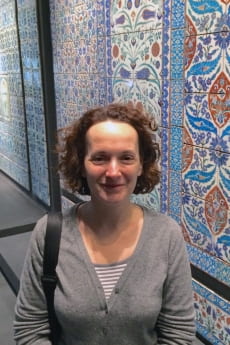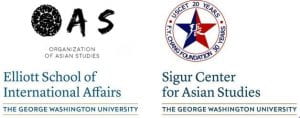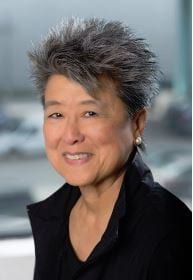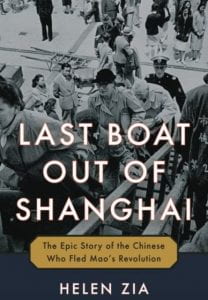
Professor Janet Steele, Associate Professor of Media and Public Affairs and International Affairs, was quoted in a Time article published on February 21st titled “The Message Behind Maria Ressa’s Cyber Libel Arrest.”
Sigur Center for Asian Studies
At the Elliott School of International Affairs

Professor Janet Steele, Associate Professor of Media and Public Affairs and International Affairs, was quoted in a Time article published on February 21st titled “The Message Behind Maria Ressa’s Cyber Libel Arrest.”

Professor Stephen Kaplan, Associate Professor of Political Science and International Affairs, co-authored an article published in the Washington Post on February 22nd titled “China and Russia have deep financial ties to Venezuela. Here’s what’s at stake.”

By Yehna Bendul, Research Staff Assistant, Sigur Center for Asian Studies
The National Bureau for Asian Research’s (NBR) latest publication, Strategic Asia 2019: China’s Expanding Ambitions, defines China’s strategic goals and analyzes its attempts to reshape the international order. On February 7th, the Sigur Center and NBR held a series of discussions to mark the release of the publication. Randall G. Schriver, the Assistant Secretary of Defense for Asian and Pacific Security Affairs and the keynote speaker for the event, discussed how the Department of Defense characterizes the future with China as well as how the United States plans to respond.
Assistant Secretary Schriver began his remarks by acknowledging that past defense strategies have been unclear in their hierarchies of priorities but emphasized that the 2018 strategy sees interstate competition as its primary focus. Within this focus on interstate competition, China is seen as the most prominent competitor to the United States. Assistant Secretary Schriver cited China’s simultaneous exploiting and undermining of international norms and the liberal rules-based international order as the primary reason for competition. This was followed by a concern for China’s authoritarian principles and violations of other countries’ sovereignties with the intent to spread such principles. Lastly, Assistant Secretary Schriver stressed that the fact that China sees itself in competition with the United States is reason enough to reciprocate.
Assistant Secretary Schriver discussed five ways in which the United States plans to adapt and respond to China’s challenge. First is that the U.S. armed forces need to understand that it can be contested and that this conflict will not be “an easy win,” as China is rapidly modernizing its military. Second, the United States can no longer look at competition through a binary lens. That is to say, the mindset of expecting clear wins and losses on a day-to-day basis is unproductive. Not only does China engage in “salami-slicing tactics” – or a piecemeal style strategy that seeks to gradually and selectively change the status quo – but China also keeps its activity in the “gray zone.” In other words, China acts in coercive and aggressive ways but deliberately limits its activities to remain just below the threshold of what would trigger military retaliation. Thus, Assistant Secretary Shriver argues that competition with China will require the United States to remain vigilant even among seemingly innocent action.
The third, and one of the most crucial, components of the U.S. defense strategy in the Asia-Pacific is strengthening relationships with allies and partners in the region. China has both a geographical and a first-mover advantage which limit the scope of unilateral U.S. action. Thus, the United States must rely on good relations with countries in the region to project power and counter China. Fourth, Assistant Secretary Schriver stressed the importance of informing allies and others of the reality of the Belt Road Initiative and other ostensibly economic ventures like 5g infrastructure investment. While more countries are becoming aware of the military and political objectives associated with these projects, Assistant Secretary Schriver acknowledged that simply shining light on the situation is not enough. Competition on this front will require the United States to ensure that it can provide alternative options for countries to turn to, thus requiring investment in our own infrastructure projects and 5g technology. Lastly, the United States needs to recognize that this competition will extend beyond the current generation, and as such must conduct long-term planning accordingly. Assistant Secretary Schriver concluded his talk by stating that this strategy is inclusive and positive in that its priority is protecting important and enduring principles. To him, the trajectory of the conflict can be peaceful, but the onus is on China to stop violating these principles.
This last note echoes a point that NBR panelist and Senior Policy Analyst at USIP, Dr. Patricia Kim, made during her remarks which was that U.S. strategy in the Asia-Pacific region should not just be a policy of containment of China but rather something broader and focused on more positive goals. She added that states in the region have no desire to be forced to choose between the United States and China and that it is U.S. support for democracy, free trade, and other such principles that fundamentally underpin its soft power in the region. While it is essential to signal to China that destabilizing actions will not be tolerated, a necessary part of this kind of positive strategy is reassuring China that the United States does not seek to keep China down. Dr. Kim asserted that an aggravated and isolated China is just as destabilizing, if not more, than what it is now.
A serious problem with this strategy, however, is that the United States’ own track record of following international norms and laws is not an exemplary one. This question of how the United States can claim to be acting out of a desire for global justice and according to norms and laws when it has historically failed to do so was brought up in the Q&A session. Assistant Secretary Schriver’s response was that the question cherry-picked examples and that in every case, there were justified trade-offs. However, there is a plethora of examples to look to where the United States either explicitly violated laws (such as the Iran-Contra Affair) or took morally and legally questionable actions (such as the “Highway of Death”). Even now, the United States has yet to sign the United Nations Convention on the Law of the Sea (UNCLOS) but holds China to those exact standards in the South China Sea. Consequently, any attempts to try to convince China and others in the region that United States intentions are based more on principle than geopolitical interests seem somewhat futile or questionable at best.
Moreover, there are major concerns about the U.S. Department of Defense’s ability to actually implement its strategy. Analysis from the Center for Strategic and International Studies not only stress a history of dysfunctionality but a number of structural and budgetary concerns that would make effectively implementing a long-term strategy in a cohesive manner improbable. The departure of Secretary of Defense Jim Mattis only adds to the troubles and challenge of China. While the United States is not alone in facing internal challenges, it is clear that China is quickly becoming, if not already, a genuine competitor. Whatever the outcome is between these two great powers, there will be significant and complex impacts on the rest of the world.
 Yehna Bendul is a sophomore in the Elliott School studying Philosophy and International Affairs. Her concentration is in international politics with a focus on Latin America and East Asia.
Yehna Bendul is a sophomore in the Elliott School studying Philosophy and International Affairs. Her concentration is in international politics with a focus on Latin America and East Asia.

Professor Mika Natif, Assistant Professor of Art History, was interviewed in the Indian Cultural Forum article, “Did Akbar really examine paintings every week? All the World’s a Mughal Stage” by Somok Roy. In the interview, Professor Natif discusses her new book Mughal Occidentalism (Brill, 2018).

Professor David Shambaugh, Director of the China Policy Program and affiliated faculty member at the Sigur Center for Asian Studies, was mentioned in the South China Morning Post article, “Think smarter and carry a bigger stick in Asia, China-watchers urge US President Donald Trump’s administration” by Jodi Xu Klein. Professor Shambaugh was mentioned as a contributor to the report “Course Correction: Toward an Effective and Sustainable China Policy.”

Professor Gregg Brazinsky, affiliated faculty member at the Sigur Center for Asian Studies, was quoted in the Wall Street Journal article, “U.S. Envoy Voices Optimism Ahead of North Korea Nuclear Summit” by Andrew Jeong and Timothy Martin.

Professor Mika Natif, Assistant Professor of Art History, was a recipient of a Sigur Center travel grant that helped her travel to India for a new research project. Read below for a description of her trip!
Over the break I went to India in order to start my new research project, focusing on Mughal female patrons, artists and portraiture. During this trip I visited palaces, museums, special libraries, and private collections in Delhi, Jaipur, Ajmer, Jodhpur and Rampur. I was mostly looking for images of women related to the Mughal courts during the times of Emperors Akbar, Jahangir and Shah Jahan. I also wanted to see the places from which some of these women, wives, concubines and court ladies came. And I was also searching for any visual and textual materials I could find that were related to this topic. In some places I got luckier than in others.
One of these amazing places was the Raza Library in Rampur, Uttar Pradesh. This incredible collection of illustrated manuscripts and albums grew out of the personal library of the nawab (governor) of Rampur, Faizullah Khan, in end of the 18th century. The current beautiful building was constructed about one hundred years later to house the ever-growing library of rare specimens in Persian, Urdu, Arabic, Sanskrit, and other languages. Working at the Raza library, I was looking at portraits of Mughal women, especially of Nur Jahan, as well as illustrated historical texts, such as Rashid al-Din’s World History (Jami al-Tawarikh). I would like to thank Dr. Abu Sad Islahi and Faisal Khan for their generosity and help throughout my visit.
In my last days in New Delhi, I gave a lecture at the Jawaharlal Nehru University (JNU). Prof. Kavita Singh invited me to celebrate the publication of my new book “Mughal Occidentalism” and I was delighted to do so in India, not too far from the Mughal palace itself. The lecture was a wonderful opportunity to see old and new colleagues, and meet with graduate students to discuss their work.
Climbing up the stairs to visit the Rajput palace in Amer, Rajasthan
Entrance gate to the first courtyard at Amer fort. The floral wall paintings depicted on the gate are linked to Mughal art.
the Main road leading to the Chishti dargah (shrine) at Ajmer, Rajasthan. Several of the royal Mughal women were followers of Chishti sufi shaykhs, and like Akbar and Jahangir, they also went on pilgrimage to visit this shrine.
Looking at an illustrated manuscript of the World History (Jami al-Tawarikh) by Rashid al-Din.
Persian manuscript with Mughal seals and Emperor Shah Jahan’s handwriting on the flyleaf. Raza Library, Rampur.
Presenting my book to Dr. Abu Sad Islahi, as a gift to the Raza Library collection.
Prof. Kavita Singh introducing “Mughal Occidentalism” before my lecture at JNU, New Delhi.

Wednesday, February 13, 2019 5:00 PM – 6:00 PM
Elliott School of International Affairs
Room 505
1957 E Street, NW, Washington, District Of Columbia 20052

The Sigur Center and the Elliott School’s Leadership, Ethics, and Practice Initiative cordially invite you to a lunch discussion on the ethical and leadership challenges Ambassador Rich Verma encountered throughout his career.
Ambassador Richard Verma is Vice Chairman and Partner at The Asia Group. He previously served as the U.S. Ambassador to India from 2015 to 2017, where he is credited for the historic deepening of bilateral ties. From 2009 to 2011, he served as the Assistant Secretary of State for Legislative Affairs at the U.S. Department of State.
A leading expert on trade and diplomacy in Asia, Ambassador Verma brings 25 years of experience across senior levels of business, law, diplomacy, and the military.
This event is on the record and open to the media.

Friday, February 15, 2019 11:30 AM – 1:00 PM
Elliott School of International Affairs
Lindner Family Commons, Room 602
1957 E Street, NW, Washington, District Of Columbia 20052


Join Asian American Author and Activist, Helen Zia as she presents her new book, “Last Boat Out of Shanghai”. As her book title suggests, “Last Boat out of Shanghai: The Epic Story of the Chinese who Fled Mao’s Revolution” is about war and revolution in China and the exodus that accompanied crisis and social turmoil.
The book is a narrative of real people, their personal lives in Shanghai 1937-1949, and later as migrants and refugees to the US and elsewhere as they got caught up in Korean War and the Cold War’s global politics. “Last Boat out of Shanghai” is as much about Asian Americans as global migration and is very relevant to current concerns about immigration and refugee crises.
Speakers:
Moderated by Ambassador Julia Chang Bloch, President, U.S.-China Education Trust and former U.S Ambassador to Nepal with introductory remarks by Ambassador Reuben Brigety II, Dean of the Elliott School.
Program:
11:30 a.m. – 12:30 p.m.- Event
12:30 p.m. – 1:00 p.m. – Book signing with author, Helen Zia and a light lunch
This event is on the record and open to the media.

Donald Clarke, professor of law, was interviewed by Canada’s CTV News Channel about a letter he signed calling for China to release two Canadian citizens being detained.
The views expressed in this article are solely those of the author and not of the Sigur Center. In the spirit of open academic debate and dialogue, the Sigur Center shares and highlights the works of its affiliated faculty. However, the views expressed within articles are those of the author and not of the Sigur Center.